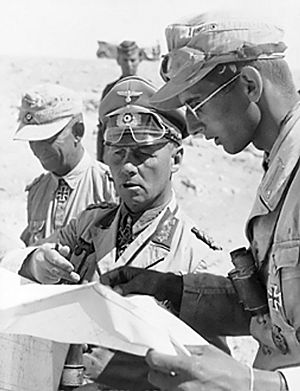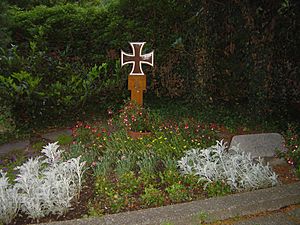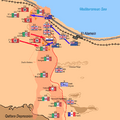Erwin Rommel facts for kids
Quick facts for kids
Erwin Johannes Eugen Rommel
|
|
|---|---|
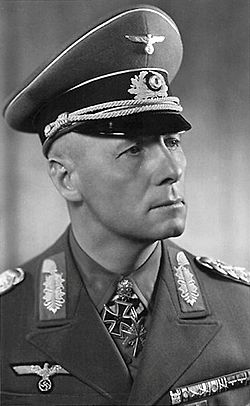
Field Marshal Erwin Rommel
|
|
| Nickname(s) | "Wüstenfuchs" ("Desert Fox") |
| Allegiance | German Empire (to 1918) |
| Years of service | 1911–1944 |
| Rank | Field marshal |
| Commands held | 7th Panzer Division Afrika Korps Panzer Army Africa Army Group Africa Army Group B |
| Battles/wars | World War I
|
| Awards | Pour le Mérite Knight's Cross of the Iron Cross with Oak Leaves, Swords, and Diamonds Military Merit Cross (Austria-Hungary) |
| Spouse(s) |
Lucia Maria Mollin
(m. 1916) |
| Children |
|
- Desert fox can also refer to the Fennec fox
Field Marshal Erwin Johannes Eugen Rommel (born November 15, 1891 – died October 14, 1944) was a famous German officer during World War I and World War II. He was often called the "Desert Fox" because of his clever tactics in battle.
During World War II, Rommel led the German army in North Africa. There, he fought against the British 8th Army for a long time. He was eventually defeated at El Alamein. Later in the war, he was in charge of German forces defending the coast of France against the Allied Normandy invasion.
Rommel was well-liked by the German people and respected by his enemies. He was seen as a fair and kind leader, unlike some other German commanders. His famous Afrikakorps (German Africa Corps) was not accused of any war crimes. Soldiers captured by his army were treated well. He even ignored orders to harm captured Jewish soldiers and civilians.
Rommel knew about a plan by some senior officers to remove Hitler from power in 1944. When the plan failed, those involved faced severe punishment. Rommel was forced to take his own life. His death was announced as if he had died heroically in battle.
Contents
Early Life and Military Start
Erwin Rommel was born in Heidenheim, Germany, on November 15, 1891. This town was about 45 kilometers (28 miles) from Ulm. His father was a math teacher. His mother was Helene von Lutz. Erwin was the second of four children. He later wrote that his early years were "very happily" spent.
When he was 14, Rommel and a friend built a glider that could fly short distances. Young Erwin was good with technical things and thought about becoming an engineer. However, he joined the local 124th Württemberg Infantry Regiment as an officer cadet in 1910. Soon after, he went to the Officer Cadet School in Danzig. He finished school on November 15, 1911, and became a lieutenant in January 1912.
While at Cadet School in 1911, Rommel met Lucia Maria Mollin, who was 17. They married on November 27, 1916. On December 24, 1928, they had a son named Manfred, who later became the mayor of Stuttgart. Manfred passed away in 2013. Rommel also had a daughter named Gertrud from another relationship.
Rommel in World War I
In World War I, Rommel fought in France, Romania, and Italy. He first served with the 6th Württemberg Infantry Regiment. Later, he joined the Württemberg Mountain Battalion of the Alpenkorps. During this time, he became known for making quick decisions and surprising the enemy. He was wounded three times and received the Iron Cross; First and Second Class.
Rommel also earned Prussia's highest medal, the Pour le Mérite. He received this award after fighting in the mountains of west Slovenia. His battalion played a key role in capturing Mount Matajur and many Italian soldiers and artillery pieces. His unit also used gas during battles and helped the Central Powers win at the Battle of Caporetto. Rommel was briefly captured by the Italians but escaped and returned to German lines within two weeks.
Rommel in World War II
Poland Campaign 1939
Rommel was a commander in the Führerbegleithauptquartier (Hitler's escort headquarters) during the Poland campaign. He often traveled close to the front lines with Hitler. After Poland was defeated, Rommel helped organize Hitler's victory parade in Berlin. He even took part in it as part of Hitler's group.
France Campaign 1940
Rommel asked Hitler to let him command a panzer (tank) division. On February 6, 1940, three months before the invasion of France, Rommel was given command of the 7th Panzer Division. This was for "Case Yellow," the invasion of France and the Low Countries. Some other officers disagreed with his promotion because he didn't have much experience with tanks. However, Rommel had seen how useful tanks were in Poland. He eagerly learned and developed new tank warfare methods.
His decision to lead a tank division turned out to be excellent. In May 1940, his 7th Panzer Division became known as the "Ghost Division." This was because they moved so fast and attacked so quickly that they were often far ahead of the rest of the German army.
North Africa 1941–1943
Because of his success, Rommel was promoted. He was put in charge of the 5th Light Division and the 15th Panzer Division. These units formed the Deutsches Afrikakorps. They were sent to Libya in early 1941 to help the Italian troops. The Italians had been badly defeated by British forces.
It was in Africa that Rommel became most famous as a commander. He used clever tactics in the desert, earning him the nickname "Desert Fox."
Rommel's Character
Rommel was respected by both the German people and his enemies. Stories about his fairness and tactical skills earned him the admiration of many Allied leaders, including Winston Churchill and Bernard Montgomery. Rommel also respected his enemies. Hitler considered Rommel one of his favorite generals.
The Afrika Korps was never accused of any war crimes. Rommel himself called the fighting in North Africa Krieg ohne Hass — "war without hate." There are many examples of his good character. He refused to follow Hitler's order to harm Jewish prisoners. When British Major Geoffrey Keyes was killed during a raid behind German lines, Rommel ordered him to be buried with full military honors. Also, when building the Atlantic Wall, Rommel made sure French workers were paid for their labor, not forced to work as slaves.
Rommel's Death
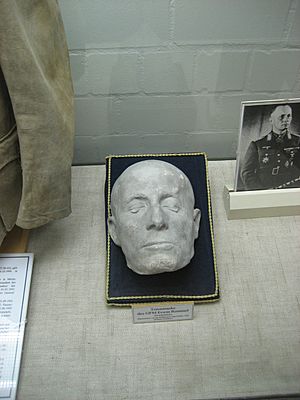
Rommel was not part of the group that planned the bomb attack on Hitler's life. In fact, he was against killing Hitler. Rommel believed that such an act could cause a civil war in Germany and Austria. He thought Hitler would become a hero if he were killed. Instead, Rommel wanted Hitler to be arrested and put on trial for his actions. However, Rommel later decided to support the plot.
After the bomb attack failed on July 20, 1944, many people involved were arrested. Rommel was worried about this. It wasn't long before his connection to the plot was discovered.
Under questioning, one of the arrested plotters revealed the names of several high-ranking army officers who had been consulted. Rommel was one of them.
Even more damaging, Carl Goerdeler, a main civilian leader of the resistance, had written in several documents that Rommel was a possible supporter. He also wrote that Rommel would be an acceptable military leader if their plan succeeded. Nazi officials in France also reported that Rommel had often criticized Nazi mistakes and crimes. This sealed his fate.
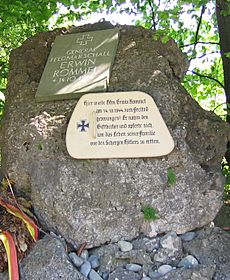
Rommel was forced to take his own life on October 14, 1944. His death was officially announced as a heroic death in battle. The movie The Desert Fox: The Story of Rommel (1951) later helped make him one of the most well-known and respected leaders in the German Army.
Images for kids
-
Rommel and Adolf Hitler in Goslar, 1934
-
Hitler in Poland (September 1939). Rommel is on his left and Martin Bormann on his right.
-
Second Battle of El Alamein. Situation on 28 October 1942
-
Generalfeldmarschälle Gerd von Rundstedt and Erwin Rommel meeting in Paris
-
Tomb of Erwin Rommel in Herrlingen (2019)
-
Rommel and Vice Admiral Friedrich Ruge visiting the U-boat base in La Rochelle, France, February 1944
-
Street sign for Avenue du Capitaine N'Tchoréré in Airaines
-
Rommel at a Paris victory parade (June 1940). Rommel had access to Reich Minister of Propaganda Joseph Goebbels via a senior propaganda official Karl Hanke, who served under Rommel during the 1940 campaign.
-
One of the many propaganda photographs of Rommel on inspection tours of the Atlantic Wall
-
Rommel with Hans Speidel, who was involved in the 20 July plot.
-
Memorial to Erwin Rommel in Heidenheim, Germany
See Also
 In Spanish: Erwin Rommel para niños
In Spanish: Erwin Rommel para niños


